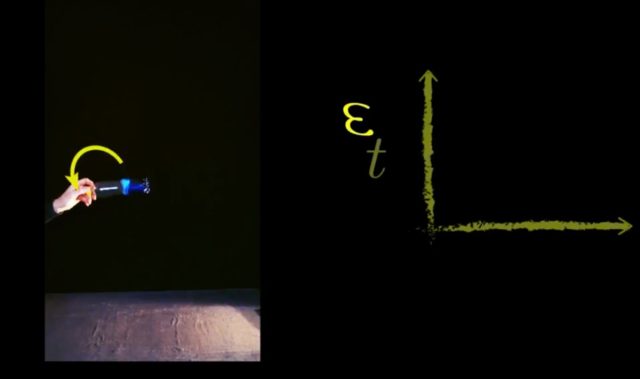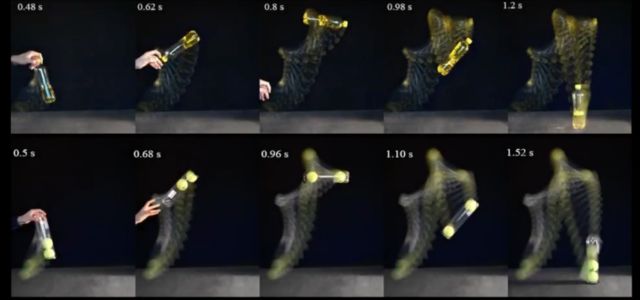The water bottle flipping craze, in which a partially filled bottle of water is flipped and magically lands upright, swept the globe a couple of years ago. Now a group of Dutch scientists has designed a classroom demo version of the feat, described in a recent paper in the American Journal of Physics. It's designed to illustrate the principle of conservation of angular momentum, and includes handy tips on how to optimize your chances of successfully performing the trick.
The whole craze started back in May 2016, when a high school senior named Michael Senatore swaggered onto a stage and successfully flipped and landed a water bottle on a table during his school's annual talent show. The crowd went wild and someone in the audience captured the feat with a smartphone camera. The resulting 30-second YouTube clip has garnered more than 8 million views, and sparked a wave of copycat attempts around the world. The Backyard Scientist performed a version using a mercury-filled cylindrical container.

Explanations for the underlying physics quickly made the rounds as well, based on slow-motion playbacks of the motion of both the bottle and the liquid inside. The consensus: the motion of the bottle though the air causes the liquid to climb up the sides, thereby redistributing the mass and increasing the bottle's moment of inertia. That has a damping effect on the rotation, slowing it down just enough in time to stick the landing.
Think of how ice skaters extend their arms and legs to slow down rotation coming out of jumps or spins. It's the same principle: conservation of angular momentum. Once the bottle is set in motion, its angular momentum remains constant. But shifting how the mass inside (the water) is distributed increases the bottle's rotational inertia (how much force is required to start or keep it moving). This slows down the bottle's rotational speed.
Physicists from the University of Twente in the Netherlands decided to analyze the underlying physics more thoroughly in a series of rigorous experiments and develop a theoretical model. For the first version of the experiment, they used a partially filled water bottle. For the second version, they reduced the variables from the large number of water molecules in the bottle to just two tennis balls in a cylindrical container.

In both cases, their measurements clearly showed the dramatic decrease of the container's rotational speed, resulting in a nearly vertical descent so the bottle landed neatly and upright. Tracking the sloshing of the liquid, and the changing positions of the tennis balls, demonstrated the redistribution of mass, shifting the moment of inertia.
If you've ever tried to do this yourself, you know the trick won't work with a full bottle: there's not enough space for the water to move, so you don't get the same shift in the moment of inertia. But just how much water is optimal was a matter of some debate. Anecdotally, the optimal level of water in the bottle should be between 1/4 and 1/3 of the container. That's in line with a 2012 paper on the impact dynamics of hollow spheres partially filled with fluids, which concluded that a container filled to 30 percent capacity is the optimal amount to achieve the crucial damping effect. And it's in keeping with the predictions of the Twente scientists' model.
The best part is that both experiments can easily be replicated in the classroom, making the water bottle flipping trick more than just a short-lived fad. It's an ideal tool for teaching undergraduate students the basics of rotational mechanics.
DOI: American Journal of Physics, 2018. 10.1119/1.5052441 (About DOIs).
[contf] [contfnew] 
Ars Technica
[contfnewc] [contfnewc]







